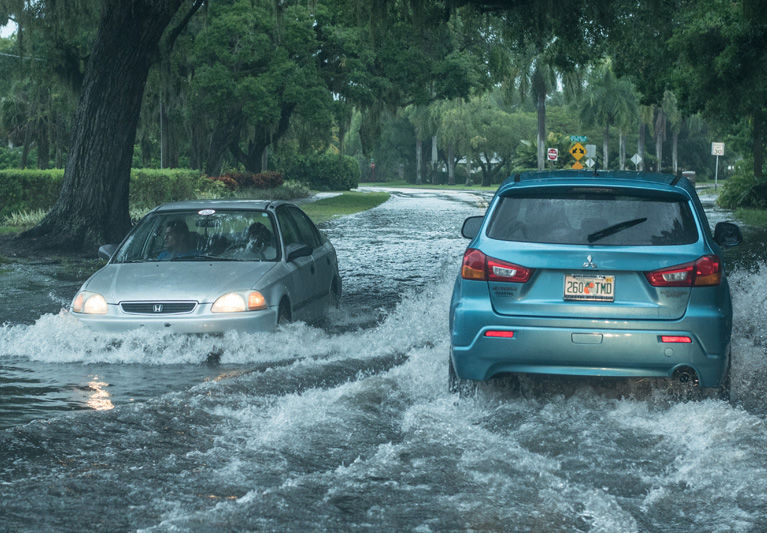
With last week’s downpours marking the “wettest day in history” for Vero Beach, flooding low-lying areas, closing schools and cancelling events, the storms more than doubled the usual volume of water in the city sewer system and utility crews scrambled to deal with weather-related outages and malfunctions.
More than 11 inches of rain fell in a single day, setting a record for the 74 years the National Weather Service has been tracking rain data for the area. “The storms produced hail, strong winds, lightning and flooding. During the storms, we experienced 30 breaker actions, multiple county-wide outages, equipment damage due to lightning, etc.,” Vero Electric Operations Director Ted Fletcher said.
Fletcher and his crews have been battling a weary transmission and distribution system for months, with an estimated $20 million needed over the next five years to bring all the components and equipment back to their optimum readiness.
“Most of our outages [during the storm] ranged from one to 50 customers with one outage resulting from an open feeder at west substation that resulted in approximately 800 customers being out. Some of our customers experienced outages in durations of one to two hours and some for durations of three to six hours,” he said.
When customers are in the dark for hours, Fletcher said, it’s typically not a simple fix under ideal conditions. “The delay in restoration to our customers is due to many factors. We experienced damaged equipment that had to be replaced, our linemen had to be pulled off of the field due to tornado warning and to seek shelter. Due to a second wave of storms passing through, some of our customers experienced back-to-back outages.”
City Council members praised the staff for the hands-on attention and extra hours and effort devoted to the weather-related problems. At last Thursday’s City Council meeting – which was cancelled Tuesday night due to weather – city officials noted that, ironically, like many private citizens who were trapped at their offices or homes by the storms, some key city employees were held captive at City Hall and other municipal facilities by the flood waters, so their service during the storm was somewhat involuntary.
Water and sewer Director Rob Bolton said there were no significant snafus in the water or wastewater system due to power outages “We went from a flow below 3.0 million gallons a day on Monday to over 8.0 million gallons [the next day, but] the sewer plant did real well and the deep injection well handled the flow. The sewer system had two manholes that overflowed in the Country Club area today due to a lot of stormwater entering the system.” Reports are that volume actually rose to 11 million gallons the day after the storm as heavy rains continued.
Vero has been working the past few years to beef up its capacity for handling large volumes of stormwater through grant funding and the use of innovative strategies like porous paving materials. The city has also been studying the prospect of establishing a stormwater utility tax to fund projects sooner rather than later.
In the meantime, it appears that the efforts by Public Works Director Monte Falls and his staff to clean out drains and install baffle boxes at major stormwater outfall points have paid off.
After a power outage in February caused a Vero Beach Utilities boil water notice and mass confusion among city, county and Indian River Shores residents, Vero started looking into ways to better communicate with utility customers. The city also implemented an interim patch of utilizing the Vero Beach Police Department’s established social media network to get information out.
City Manager Jim O’Connor said his staff didn’t have the time to get the notification systems up and running prior to this freak May storm, though he’s hopeful about having something in place before the height of hurricane season at the end of the summer. “Only the notice by the City’s website and Facebook are being used now. We are in the process of developing a notification system with the use of our customer accounts but need to work through system security,” O’Connor said.
Over at Indian River County Utilities, Utility Director Vincent Burke said parts of the county wastewater system handled triple the normal volume due to the storms. Of the county’s three treatment plants, the south plant surged from its typical 500,000 to 600,000 gallons per day to 1.5 million gallons per day. The central plant also saw an uptick from 2.25 million gallons to 3.5 million gallons and the western plant increased its flow from 2.5 million gallons to 3.6 million gallons.
“We had lift stations under water and we lost power at some lift stations, but were able to go in with our vacuum trucks after the power came back on and fortunately we had no power outages at the plants,” Burke said, noting that the plants have backup generators that kick in when power is lost.
“We have some really awesome guys who really stepped up, some lift-station mechanics who worked until 3 a.m. to keep everything going and to keep chlorine levels up and within Florida Department of Environmental Protection requirements. Was it difficult – yeah, but we’re certainly thankful for the efforts of these men and women who keep it all running,” Burke said.
Meanwhile, in Indian River Shores, the weather caused few problems for public officials.
Shores Public Safety Chief Rich Rosell said, “We fared much better than the mainland. No issues to report at all.”
Town Manager Robbie Stable concurred with Rosell, saying, “I was pleasantly surprised that we were able to handle such a storm event. My office was made aware of no significant flooding issues.”



